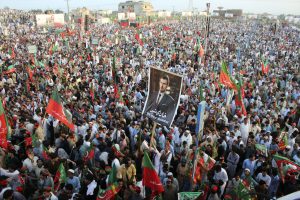After Bangladesh, is Pakistan next?
Has Pakistan’s “Monsoon Revolution” moment arrived against the backdrop of a political, economic, and security poly-crisis confronting the country? These questions have been circulating on social media since former Bangladeshi Prime Minister Sheikh Hasina’s resignation and escape to India on August 5. They warrant some scrutiny.
Following the ouster of Prime Minister Imran Khan in April 2022, the state-society gap in Pakistan has grown alarmingly as the economy has faltered and governance has vanished. The masses are disgruntled as they are struggling to make ends meet.
Currently, Pakistan, South Asia’s second-largest country, has the highest inflation rate in the region, with 12.5 million people living below the poverty line and another 95 million struggling with poverty. According to the Pakistan Economic Survey, around 4.5 million youth are unemployed; Pakistan’s 11 percent unemployment rate is the highest in South Asia. As many as 1.6 million Pakistanis have left the country in the last two years for better employment opportunities and living standards in the Middle East and Europe.
Furthermore, Pakistan’s border-fencing with Afghanistan and Iran to formalize the informal border economies as well as the installation of the internet firewall will render more young people jobless in the informal and freelance sectors, respectively. In the restive Khyber Pakhtunkhwa and Balochistan provinces, millennials like the Pashtun Tahaffuz Movement’s Manzoor Pashteen and the Baloch Yakjehti Committee’s Mahrang Baloch have captured the imagination of angry youth who are protesting against the state’s atrocities.
So, is Pakistan poised for a Gen-Z revolution? Not quite.
Despite some stark parallels with the situation in Bangladesh, Pakistan is unlikely to witness a revolution for the following four reasons.
First, some people argue that Pakistan is like a tinderbox and one flame will ignite nationwide protests like those in Bangladesh. However, unlike Bangladesh where a semblance of homogeneity shaped protests and anger against the Awami League (AL) government into a national movement, Pakistan’s ethnic heterogeneity and fragmented political landscape undermine a nationwide uprising.
The ongoing protests in Balochistan and Khyber Pakhtunkhwa did not create a ripple effect in Punjab and Sindh, where the overwhelming majority of the population resides.
Living standards in Punjab and Sindh have deteriorated. Like Balochistan and Khyber Pakhtunkhwa, Punjab has witnessed enforced disappearances of the Pakistan Tehreek-e-Insaf ‘s (PTI) political activists after the May 9 riots last year. However, instead of revolting, Punjab and Sindh’s skilled laborers and the professional class are leaving the country for greener pastures in the West and the Middle East. So, there is no converging point or a unifying figure that integrates the scattered protest movements into a large-scale national movement. The scattered nature of existing protest movements makes it easier for the Pakistani establishment to control the situation.
Second, unlike Bangladesh where AL ruled the country for 15 years and Hasina won four consecutive terms, Pakistan has been ruled by three different parties during the same period. In the last two decades, no dispensation in Pakistan has won two consecutive elections. Furthermore, due to split public mandates and hung parliaments, Pakistan has witnessed coalition governments as opposed to AL’s one-party rule in Bangladesh. In fact, Khan’s ouster in a parliamentary no-confidence vote in April 2022 was initiated after the latter tried to push Pakistan toward alleged one-party rule with the help of former spy chief Lt-General (Retired) Faiz Hameed.
If Pakistan ever came closer to a revolution, it was on May 9 last year, which the military ruthlessly crushed. A repeat of May 9 is highly unlikely at this juncture.
Third, unlike Hasina who incarcerated the entire opposition and ruled Bangladesh single-handedly with an iron fist, Pakistan’s major political parties are part of the current status quo. For instance, the PTI is ruling in Khyber Pakhtunkhwa, the PPP is running Sindh and Balochistan provinces, while the PMLN is in charge of the center and Punjab. So, despite intractable political differences, unresolved electoral disputes and a never-ending game of thrones, Pakistan’s major political parties are invested in the system and are seeking resolution through legal and political means.
Finally, the most critical variable that differentiates Pakistan from Bangladesh is its powerful military establishment. Hasina’s regime fell like a house of cards when the Bangladeshi military withdrew its support and refused to open fire on the Gen-Z protesters marching toward Dhaka. In contrast, the Pakistani military establishment is firmly supporting the PMLN-led coalition government. To use Pakistan’s former ambassador to the U.S. Hussain Haqqani’s expression, the current political set-up in Pakistan is “a military rule with a civilian façade.” So, the military’s stakes in the current status quo are deeply entrenched.
After securing a staff-level agreement for a three-year Extended Fund Facility of $7 billion from the International Monetary Fund, the military will go to any extent to back the existing dispensation to ensure the continuity of economic policies.
In a surprising turn of events on August 12, the military announced court martial proceedings against Faiz Hameed for corrupt practices and violating the Pakistan Army Act, including his role in the May 9 riots. Three more mid-ranking former military officers have also been detained for assisting Hameed. This is a second wave of a purge within the Pakistani military. Reportedly, after the May 9 events, the military sacked three officers for failing to stop PTI protesters from ransacking the military installations.
Pakistan Army Chief General Asim Munir weathered the May 9 mutiny; another institutional uprising against him is highly unlikely. It bears mention that the Pakistan Army has never witnessed an internal coup as have several Latin American countries.
In sum, although the current economic, political, and security situation in Pakistan is far worse than in Bangladesh, the Gen-Z revolution in Pakistan will have to wait for some time.

































